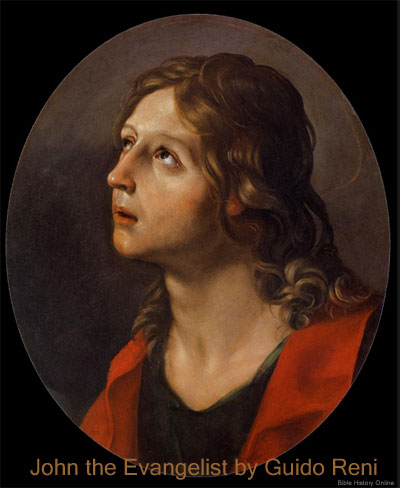John Images and
NotesThe Book of John
John 1:14 - And the Word was made flesh, and dwelt among us,
(and we beheld his glory, the glory as of the only begotten of
the Father,) full of grace and truth.
John 20:31 - But these are written, that ye might believe
that Jesus is the Christ, the Son of God; and that believing ye
might have life through his name.
John in The New Testament - A Brief Overview

Painting of St. John the Evangelist by Reni - 1620
Introduction to The
Gospel of John
The Word Gospel. The fourth book of the New
Testament is the Gospel of John.
John is the fourth of the four gospel writings, yet there is
only one gospel about Jesus Christ and there are four different
writers: Matthew, Mark, Luke, and John. The word "Gospel"
means "good news", and the good news is about Jesus
Christ dying on the cross and then 3 days later conquering death
and rising from the dead, offering salvation to all mankind,
this is the Gospel.
Summary of The Book of John
Brief Summary. Jesus was Jehovah God, the eternal Word
made flesh. He came to His home, Israel, and He was rejected. He
came to this world, and the world rejected Him, but anyone who
would believe and receive Him would have life through His name,
and be given authority to call themselves a "son of god."
Purpose. John makes one thing clear in John 20:30, 31
- "these ( things) are written that ye may believe that Jesus is
the Christ; and that believing ye may have life in his name."
John sought to lead men to eternal life by first convincing them
of His deity, the miracles were actually recorded as "signs" to
confirm His deity, that He was Jehovah God, the incarnate Word
made flesh. John called Jesus the bread of life, the light of
the world, the good shepherd, the way the truth and the life,
the true vine, all clearly pointing to the deity of Jesus. In
fact John points to everything in His life and teachings as a
sign that Jesus of Nazareth was truly the Eternal Word of God
who "became flesh and dwelt among us, full of grace and truth"
(John 1: 14).
John Compared to the Other Gospel Accounts. The
"Synoptic Gospels" - Matthew, Mark and Luke all have their
unique perspective of the life of Jesus Christ, as well as
John's approach. John is always emphasizing the deity of Jesus
as well as His divine miracles. John also gives us a bit more
information about Jesus' ministry in Jerusalem, where Matthew,
Mark and Luke focus more on His Galilean ministry. There is also
a difference regarding the chronology of the last week (Passion
Week) of Christ's life. It is important to note that the Gospel
accounts do not necessarily place their focus on chronology and
orderly biography of the ministry of Jesus with names, places,
and dates, but rather a full perspective of their unique
portrayal of Jesus Christ.
Authorship. The author of the Gospel of John is
identified in John 21:20 as "The disciple whom Jesus loved" who
leaned on Jesus' breast. It is clear that John was that disciple
and he did not wish to use his own name directly as the author,
possibly for reasons of humility. Early church historical
writings from early second century AD recognize the Gospel of
John as a sacred book. Theophilus of Antioch (170 AD) was the
first to write the name John as the author. Shortly after this Irenaeus
identified John as the disciple who had leaned on Jesus' breast.
This is especially important because Irenaeus was a disciple of
Polycarp, who had known the man John personally. Clement of
Alexandria mentions John as having composed a "spiritual
gospel."
Critics of John as the Author. There is a statement
that was made by Papias that there were actually two men named
John in Ephesus at the same time, and John the Apostle was
referred to as "John the Elder". Many opponents of the apostle
John's authorship give credit to the other John as the writer of
the fourth Gospel. Although the answer cannot be positively
determined by history, tradition and internal evidence
definitely point to John the apostle as the author.
Date. It is worthy to consider the words of the most
famous archaeologist of all time that according to
archaeological evidence there is "no longer any solid basis for
dating any book of the New Testament after about A.D. 80." Most
scholars conclude that the book of John was written around 85 or
90 AD probably before the exile to Patmos. It is also important
to consider John 5:2 when it mentions "Now there is in Jerusalem
by the sheep [market] a pool, which is called in the Hebrew
tongue Bethesda, having five porches." This verse would indicate
that this existed at the current time that the Gospel of John
was written. This would place the written work before the
destruction of Jerusalem in 70 AD. There is also no evidence as
to whether John wrote the Gospel before or after his return to
Ephesus from the Island of Patmos.
The Man John. John's book attributes the work to "the
disciple whom Jesus loved." This say a lot about the man John,
and the fact that Jesus left his mother Mary in John's care,
having spoken the words from the cross, is very significant.
Another indicator of John's character is found in the book of 1
John, he continually talks about love, loving one another, and
that God is love, etc. It is also safe to say that John was a
Jew, this can be clearly seen by his accuracy about Jewish
customs, Jewish way of thinking, and by his quotations from the
Hebrew Old Testament. He knew the topography of the land of
Israel from a Jewish perspective quite well. It is easy to see
in his writings that he was a close disciple of Jesus, an
eyewitness of the events surrounding Jesus' ministry. One can
determine by process of elimination, that the author is not just
any John but John the apostle, the son of Zebedee, who is
prominently mentioned in the Gospel accounts.
John and Church History. Church tradition
records that John came to Ephesus after Paul's work was finished
there. Later, during the reign of the Emperor Domitian, he was
banished to the Island of Patmos where he wrote the book of
Revelation. Shortly thereafter he was released and returned to
the city of Ephesus.
Archaeology. The Rylands Papyrus Fragment was
discovered in 1920 in Egypt containing a few verses from John 18
dating back to about 120-135 AD.
Outline of the Book of John
The Word of God - Chapter 1:1-51
His Public Ministry - Chapters 2:1-12:50
His Private Ministry - Chapters 13:1-17:26
His Death and Resurrection - Chapters 18:1-20:31
John's Conclusion - Chapter 21:1-25

The Name Jesus In Ancient Hebrew Text
"Yeshua" in First Century Hebrew Text. This is how the name "Jesus"
would have been written in ancient Hebrew documents. The four letters or
consonants from right to left are Yod, Shin, Vav, Ayin (Y, SH, OO, A).
Jesus is the Greek name for the Hebrew name Joshua or Y'shua which means
"The LORD or Yahweh is Salvation".
John Resources
Outline of the Life of Jesus in Harmony
Simple Map of First Century Israel
Topographical Map of First Century Israel
Map of the Ministry of
Jesus
Map of the Roads in Ancient Israel
Map of the Roman Empire






